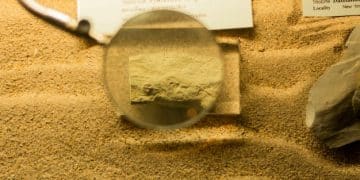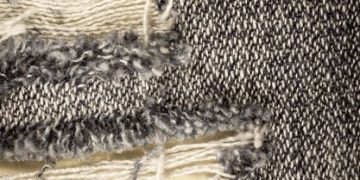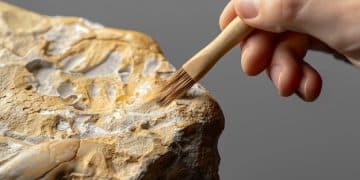US archaeological forgeries: tech for identification
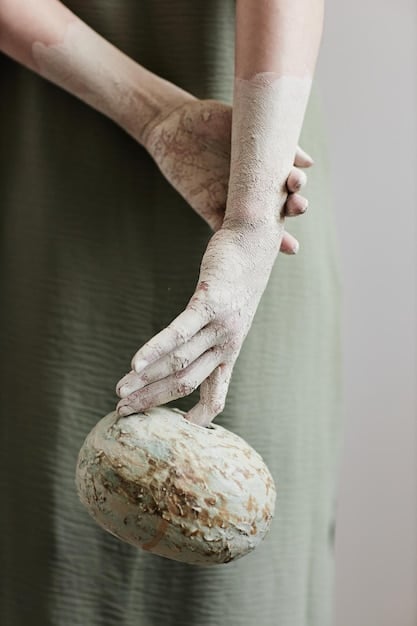
Experts in the US are increasingly leveraging advanced scientific and technological methods, including DNA analysis, carbon dating, and spectroscopy, to rigorously identify and combat archaeological forgeries, ensuring the authenticity and integrity of historical artifacts for research and public display.
The world of archaeology is typically seen as one of discovery and revelation, where the stories of humanity’s past are carefully pieced together through meticulous excavation and analysis. However, a darker side exists: the pervasive issue of archaeological forgeries in the US: how experts are using advanced technology to identify and combat fake artifacts. These modern imitations, often crafted with devious intent, not only mislead the public and distort historical narratives but also undermine the very foundations of academic research and museum collections. The challenge posed by these illicit creations is significant, demanding increasingly sophisticated methods for detection.
The enduring problem of archaeological forgeries in the US
The United States, with its rich tapestry of Indigenous cultures and colonial history, presents a fertile ground for archaeological exploration. Unfortunately, this wealth of genuine artifacts also attracts those who seek to profit from deception. Forgeries range from crude imitations to highly sophisticated fakes that can fool even seasoned collectors and some less attentive institutions. These objects, often fabricated from common materials and “aged” through various artificial processes, are then introduced into the market, blurring the lines between legitimate historical objects and mere curiosities. The enduring nature of this problem stems from a combination of high demand by collectors, the significant financial incentives involved, and historical gaps in rigorous authentication practices.
Historically, the identification of fakes relied heavily on stylistic analysis, provenance, and the keen eye of experienced experts. While these methods remain crucial, they are often insufficient against cunning forgers who study genuine artifacts meticulously to replicate their appearance and construction techniques. The sheer volume of discovered (or purported) artifacts, coupled with increasingly convincing counterfeits, necessitated a paradigm shift in how authenticity is verified. This shift is particularly vital in a country like the US, where numerous private collections exist alongside public museums, creating varied pathways for fraudulent items to enter circulation. Moreover, the internet and global trade have made it easier for forgeries to cross borders and reach unsuspecting buyers.
The historical landscape of fakes
From the notorious “Cardiff Giant” hoax of the 19th century to more recent controversies surrounding supposedly ancient Native American artifacts, the US has a long and colorful history with archaeological deceit. Early forgeries were often quite primitive, designed to exploit public fascination with newly unearthed wonders. However, as archaeological science matured, so too did the sophistication of the fakes. Forgers began to develop more elaborate techniques, sometimes even planting fake items at known archaeological sites to lend an air of authenticity. This historical context underscores the deeply ingrained nature of forgery within the broader narrative of archaeological exploration and collection in America. Understanding the evolution of forging techniques is also key to developing effective countermeasures.
Impact on museums and scholarship
The presence of forgeries in museum collections can be profoundly damaging. It can erode public trust, misinform educational programs, and, most critically, distort academic research. Scholars rely on authenticated artifacts to build theories about past societies, their technologies, and their belief systems. If these foundational artifacts are, in fact, fakes, any conclusions drawn from them are inherently flawed. The financial cost of acquiring, preserving, and exhibiting fraudulent objects is also substantial, diverting valuable resources that could otherwise be used for legitimate archaeological work or educational outreach. Furthermore, the exposure of a forgery within a prominent collection can lead to significant reputational damage for the institution involved.
Rising to the challenge: the dawn of technological authentication
In response to the growing sophistication of archaeological forgeries, experts have increasingly turned to advanced scientific and technological methods for authentication. This shift represents a move from purely subjective assessments to objective, data-driven analysis. The integration of modern technology provides unprecedented capabilities to peer into the very molecular and atomic structure of artifacts, revealing clues about their true age, composition, and manufacturing processes. This multidisciplinary approach combines the traditional wisdom of archaeologists and art historians with the analytical precision of chemists, physicists, and material scientists. The goal is no longer just to identify a fake, but to understand precisely how and when it was made, contributing to a broader understanding of the forgery ecosystem.
The core principle behind technological authentication is that genuine artifacts possess unique signatures derived from their natural degradation over time and the materials and techniques available at their time of creation. Forgers, no matter how skilled, rarely have access to these exact conditions or materials. Modern technology allows minute examination of these signatures, often non-invasively, protecting the integrity of precious objects. This new era of archaeological forensics is transforming the battle against illicit trade and ensuring the posterity of our shared cultural heritage.
- Non-destructive analysis: Many advanced techniques allow examination without damaging the artifact.
- Micro-level scrutiny: Technology enables analysis at a microscopic or even atomic level.
- Reproducible results: Scientific methods provide objective data that can be independently verified.
- Dating precision: More precise dating methods help pinpoint an object’s true age.
The need for interdisciplinary collaboration
Effective combating of forgeries requires not just technology, but also close collaboration among various experts. Archaeologists and art historians provide the contextual knowledge about artifact typologies, historical manufacturing techniques, and potential provenances. Scientists bring their expertise in material analysis, dating methods, and imaging. Legal experts and law enforcement are crucial for prosecuting those involved in the illicit trade and for establishing robust chains of custody. This synergistic approach ensures that both the “art” and “science” of authentication are fully integrated, leading to more accurate and defensible conclusions about an artifact’s legitimacy.
Advanced dating techniques: unmasking false histories
One of the most powerful tools in the tech arsenal against archaeological forgeries is advanced dating. Forgers often struggle to replicate the precise aging effects that occur over centuries or millennia. While traditional carbon dating (radiocarbon dating) remains a cornerstone, newer methods and refinements offer even greater precision and applicability to a wider range of materials. These techniques analyze the subtle atomic and molecular changes that occur naturally over time, providing an objective timeline for an artifact’s creation. The ability to accurately date an object is perhaps the most direct way to expose a modern impostor attempting to masquerade as an ancient relic.
Radiocarbon dating refinements
Radiocarbon dating, which measures the decay of carbon-14 isotopes, has been revolutionized by Accelerator Mass Spectrometry (AMS) technology. AMS requires significantly smaller samples than traditional methods, often just a few milligrams of organic material, making it suitable for even fragile or small artifacts. This precision helps distinguish between truly ancient organic components (like residue on pottery or fibers in textiles) and modern additions. While carbon dating can only be used on organic materials, it remains invaluable for a vast array of archaeological finds. The calibration curves used for radiocarbon dating have also become more refined, leading to enhanced accuracy.
Thermoluminescence and optical stimulated luminescence (OSL)
For inorganic materials like pottery, ceramics, and burnt flint, thermoluminescence (TL) and optically stimulated luminescence (OSL) dating offer robust ways to determine the last time the material was heated or exposed to sunlight. These methods measure the accumulated radiation dose in crystalline minerals since their last heating or exposure event. If a ceramic piece, for instance, claims to be 2,000 years old but its TL signature indicates it was fired only 50 years ago, it’s a clear forgery. These techniques are particularly effective because forgers cannot easily replicate the long-term trapping of electrons within crystalline structures.
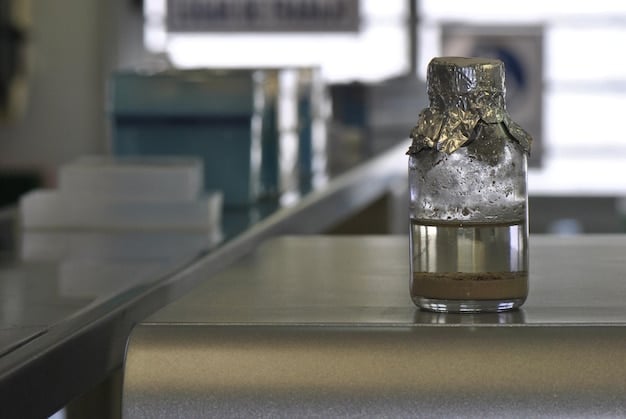
Other specialized dating methods
Beyond these prominent techniques, other specialized dating methods are also being employed:
- Dendrochronology: Analysis of tree rings can date wooden artifacts with remarkable precision, sometimes to the exact year of felling.
- Obsidian hydration dating: Measures the hydration layer on obsidian artifacts, which forms at a predictable rate after being chipped or flaked.
- Archaeomagnetism: Determines the date based on changes in the Earth’s magnetic field recorded in fired clay objects.
Each of these methods provides a unique window into the past, offering further empirical evidence to corroborate or refute an artifact’s purported age. The convergence of multiple dating results provides the highest level of confidence in authentication.
Material composition analysis: revealing the building blocks of deceit
Knowing what an artifact is made of and how its components were sourced can also be a dead giveaway for a forgery. Forgers often use materials that are readily available in the modern era, which might not have existed or been accessible during the period the artifact supposedly represents. Material composition analysis employs a suite of spectroscopic and microscopic techniques to scrutinize the atomic and molecular makeup of an object, identifying discrepancies that betray its true origin. These methods are particularly effective because they can detect even trace elements or unexpected modern contaminants.
X-ray fluorescence (XRF) and scanning electron microscopy (SEM)
XRF is a non-destructive technique that identifies the elemental composition of materials by exciting their atoms with X-rays and measuring the emitted fluorescence. This can reveal if an object contains elements not typical of its supposed period or region, or if it has modern alloys or pigments. For example, a bronze artifact claiming to be ancient Egyptian might show traces of zinc if it was cast in the 20th century. SEM, often coupled with Energy Dispersive X-ray Spectroscopy (EDS), provides high-magnification images of surface structures and elemental analysis of specific areas. SEM can reveal tell-tale signs of modern tool marks, surface treatments, or artificial patinas that are inconsistent with genuine ancient weathering. The microscopic details often hold the key to authenticity.
Infrared and Raman spectroscopy
These spectroscopic techniques analyze the molecular vibrations within materials, providing unique “fingerprints” of organic and inorganic compounds. Infrared spectroscopy is excellent for identifying organic binders, pigments, resins, and coatings. Raman spectroscopy is particularly useful for identifying inorganic pigments, minerals, and crystalline structures non-destructively. If an ancient painted artifact shows synthetic pigments or adhesives only available in recent decades, it’s a clear indicator of a fake. These methods can also differentiate between natural deterioration of materials and artificial aging processes applied by forgers, such as acid baths or heat treatments.
DNA analysis: unlocking biological secrets
While not applicable to all artifacts, DNA analysis has emerged as a groundbreaking tool for authenticating objects containing biological residues. This includes ancient human or animal remains, textiles, parchment, and even residues on pottery. By analyzing ancient DNA (aDNA) extracted from these sources, scientists can determine the species, sex, and even geographic origin of the biological material. This can be critical in cases where forgeries attempt to mimic ancient burials or unique organic artifacts. For instance, if bone fragments claimed to be from an extinct megafauna actually contain modern animal DNA, the fraud is undeniable. DNA analysis requires very carefully controlled lab conditions to prevent contamination, as even minute modern DNA samples can compromise results.
Provenance, context, and the digital frontier
While technology offers powerful insights, it does not operate in a vacuum. The scientific analysis of an artifact must always be considered alongside its provenance (the history of its ownership and location) and the specific archaeological context from which it reputedly emerged. Forgers often lack a credible provenance or fabricate one, knowing the importance of an artifact’s “life story.” The digital revolution has also brought new tools to the fight, from vast online databases of genuine artifacts to advanced imaging and digital forensics. These digital advancements are enhancing the ability of experts to cross-reference data, share information, and detect patterns of fraudulent activity globally.
The interplay between scientific analysis and thorough historical research is paramount. A piece that looks chemically authentic needs to have a plausible backstory that accounts for its discovery and journey. Conversely, a seemingly robust provenance can be quickly debunked by scientific evidence of modern materials. This holistic approach builds a stronger case against forgeries, leaving fewer loopholes for deception.
Establishing reliable provenance
A strong provenance is often the first line of defense against fakes. It involves tracing the artifact’s history from its excavation (or reported discovery) through various owners, sales, and exhibitions, often supported by documentation like photographs, sales receipts, and expert opinions. Forgers frequently forge provenance documents, but these can also be subjected to forensic analysis for authenticity. The absence of a clear and verifiable provenance is a major red flag, regardless of how “ancient” an artifact might appear. Due diligence in provenance research is a critical step for any reputable collector or institution.
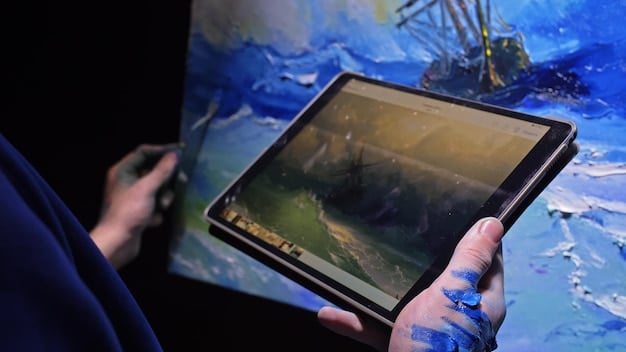
Digital imaging and 3D modeling
High-resolution digital imaging, including multispectral and even hyperspectral imaging, can reveal hidden details on an artifact’s surface, such as faint inscriptions, previous repairs, or underlying layers of pigment. These techniques can often detect anomalies invisible to the naked eye. Similarly, 3D modeling allows for precise dimensional analysis and reconstruction of artifacts, which can help in identifying inconsistencies in form or tool marks that don’t match known ancient techniques. Digital libraries are also being created to catalog the unique “fingerprints” of genuine artifacts, making it easier to compare suspected fakes against a vast database of authentic pieces.
Databases and collaborative networks
The internet facilitates the creation of comprehensive databases of genuine and known forged artifacts, shared globally among institutions, law enforcement, and researchers. These platforms allow for the rapid dissemination of information about newly discovered fakes and emerging forgery trends. Collaborative networks of experts worldwide provide a forum for shared knowledge, peer review, and collective problem-solving, dramatically improving the detection rate of sophisticated forgeries. This global interconnectedness ensures that a fake identified in one location can be flagged internationally, preventing it from resurfacing elsewhere.
Legal frameworks and ethical considerations
Beyond the scientific and historical methods, the fight against archaeological forgeries is deeply intertwined with legal frameworks and ethical considerations. The trafficking of fake artifacts often goes hand-in-hand with the illicit trade in genuine stolen or looted antiquities, raising complex issues of cultural heritage protection, property rights, and international law. Prosecuting forgers and dealers requires robust legal instruments and dedicated law enforcement efforts. Furthermore, institutions and individuals involved in archaeology and collecting have an ethical imperative to exercise extreme due diligence to avoid inadvertently promoting or legitimizing the forgery market.
Prosecuting forgery and illicit trade
In the US, archaeological forgery can fall under various federal and state laws related to fraud, misrepresentation, and the sale of counterfeit goods. When linked to the trade of looted antiquities, it can also involve laws concerning cultural property protection and international conventions. Prosecutors must often rely heavily on scientific evidence to prove the fraudulent nature of the artifacts. Challenges include demonstrating intent to defraud and tracing complex international supply chains. However, successful prosecutions send a strong message that archaeological forgery is a serious crime with significant consequences.
The impact of provenance-gaps on collections
Many museums and private collections acquired artifacts decades or centuries ago, before modern standards of provenance research were established. This leaves them vulnerable to unknowingly holding fakes or objects with problematic origins. The ethical challenge for these institutions is to retroactively research their collections, deaccessioning or repatriating items found to be forged or illegally obtained. This sensitive process requires transparency, collaboration with source countries, and a commitment to rectify historical wrongs, even if it means acknowledging past mistakes. The shift towards “clean” collections with unimpeachable provenance is a growing ethical imperative.
The future of anti-forgery efforts
The battle against archaeological forgeries is an ongoing arms race between increasingly sophisticated fraudsters and ever-evolving detection technologies. The future of anti-forgery efforts will likely involve even more advanced, non-invasive analytical techniques, relying heavily on artificial intelligence and machine learning to process vast datasets and identify subtle anomalies. Increased public awareness and education will also play a critical role in reducing demand for illicit or questionable artifacts. By combining cutting-edge science with vigilant scholarship, robust legal measures, and ethical stewardship, experts aim to safeguard the integrity of our shared human history.
AI and machine learning in artifact analysis
Artificial intelligence (AI) and machine learning (ML) hold immense promise for the future of archaeological authentication. AI algorithms can be trained on vast datasets of genuine and forged artifacts, learning to identify patterns and subtle features that might escape the human eye. This could include analyzing microscopic textures, spectroscopic signatures, or even stylistic nuances. ML models could potentially flag suspicious objects with high accuracy, assisting experts by prioritizing artifacts for in-depth analysis. This could accelerate the authentication process and make it more accessible.
Portable and miniaturized technologies
The development of portable and miniaturized analytical instruments will allow for on-site (in situ) authentication, reducing the need to transport fragile artifacts to dedicated laboratories. Handheld XRF scanners, portable Raman spectrometers, and even compact thermal imaging devices are already becoming more common. This accessibility means that initial screenings can occur earlier in the chain of custody, potentially catching fakes before they enter major collections or markets. Rapid, reliable field-based authentication will be a game-changer.
Public education and responsible collecting
Ultimately, reducing the market for forgeries requires educating the public and fostering responsible collecting practices. By understanding the ethical and scholarly ramifications of buying unprovenanced or suspicious artifacts, collectors can become part of the solution rather than inadvertently supporting illicit trade. Museums and archaeological organizations can play a vital role in this education, highlighting the importance of verified authenticity and celebrating genuine archaeological discoveries. A well-informed public is the best defense against exploitation by forgers.
The ongoing dedication to innovation and collaboration among experts will ensure that the true stories of the past, as told through authentic artifacts, continue to enlighten and inspire future generations. The investment in advanced technology and interdisciplinary research is not merely about spotting fakes; it is about preserving the invaluable cultural heritage that defines us.
| Key Point | Brief Description |
|---|---|
| 🧪 Tech Detection | Advanced technologies like XRF, SEM, and spectroscopy reveal chemical and structural inconsistencies in forgeries. |
| 🕰️ Dating Methods | Radiocarbon, thermoluminescence, and OSL precisely date artifacts, exposing modern fakes. |
| 🧬 DNA Analysis | DNA provides biological provenance for organic materials, ensuring authenticity and fighting fraud. |
| 🌐 Collaborative Effort | Interdisciplinary teams and digital networks are crucial for robust authentication and combating illicit trade. |
Frequently asked questions (FAQ)
▼
In the U.S., archaeological forgeries often include fake Native American artifacts like pottery, arrowheads, and ceremonial objects, as well as colonial-era items such as coins or documents. These can range from crude imitations to highly sophisticated fakes that replicate materials and styles intended to deceive experts and collectors, impacting historical interpretation and collection integrity.
▼
Radiocarbon dating measures the decay of carbon-14 isotopes in organic materials to determine their age. For forgeries, if an artifact supposedly from ancient times yields a modern carbon-14 signature, it definitively exposes it as a fake. This method is particularly effective for items like ancient textiles, wooden objects, or residues on pottery, providing objective temporal evidence against fraudulent claims.
▼
XRF identifies elemental composition, revealing if an artifact contains modern materials or trace elements inconsistent with its purported origin. SEM provides high-magnification images of surface features, exposing modern tool marks, surface treatments, or artificial aging processes. Together, they offer crucial insights into an object’s manufacture and material history, helping differentiate genuine artifacts from fakes.
▼
Provenance, the documented history of an artifact’s ownership and location, is critical because it establishes a credible chain of custody from discovery to current ownership. Forgers often lack or fabricate provenance documents, making a robust, verifiable history a primary indicator of authenticity. A strong provenance provides context and helps ensure that an artifact was legally excavated and traded, deterring illicit activities.
▼
Future advancements include increased use of artificial intelligence and machine learning to analyze vast datasets of artifact properties, identifying subtle patterns indicative of forgeries. The development of more portable and non-invasive analytical instruments will allow for on-site authentication, and enhanced digital imaging and 3D modeling will provide even greater detail for comparative analysis, strengthening anti-forgery efforts.
Conclusion
The relentless pursuit of truth in archaeology is a monumental task, made even more complex by the persistent threat of forgeries. The evolution of scientific and technological diagnostic tools has transformed this battle, moving beyond subjective assessment to objective, data-driven authentication. From advanced dating methods like radiocarbon dating to the precise material analysis afforded by XRF and SEM, experts are now equipped with an arsenal capable of unmasking even the most sophisticated fakes. This technological prowess, combined with rigorous provenance research and a collaborative network of institutions, safeguards the authenticity of our shared cultural heritage. As the fight continues, the unwavering commitment to ethical practices and public education will remain paramount, ensuring that the genuine stories of the past continue to illuminate our understanding of human history, untouched by deception.
